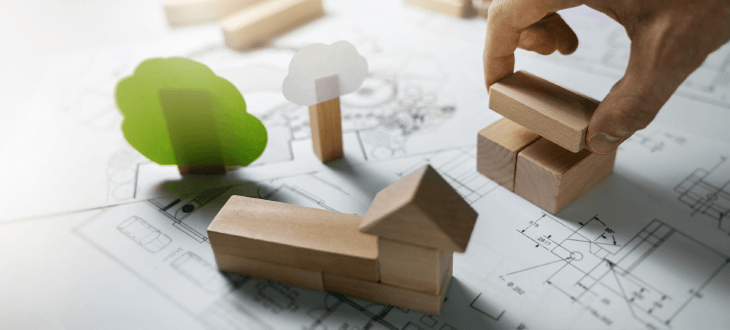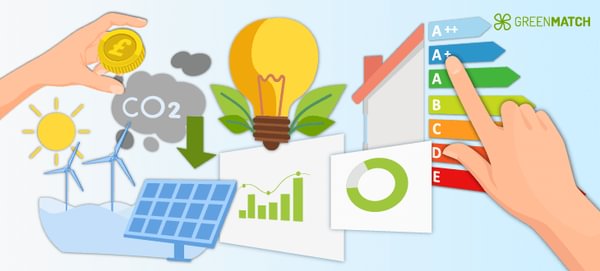- GreenMatch
- Blog
- Top 15 Sustainable Green Building Materials
Top 15 Sustainable Materials for Green Building in 2025


The adoption of sustainable green building materials continues to accelerate, driven by environmental concerns and economic benefits. The construction industry faces a pivotal moment. As climate change accelerates, the need for sustainable building practices has never been more urgent. Traditional construction materials like concrete and steel contribute significantly to global carbon emissions.
Our relentless pursuit of environmentally responsible building practices reflects our commitment to preserving the planet and represents a significant advocation for utilising renewable resources and energy-efficient solutions.
It could reduce energy consumption by 50% or more by 2050. By focusing on sustainable building materials, we're not just constructing buildings but laying the foundations for future generations to thrive in harmony with the environment.
However, a new wave of sustainable building materials offers hope for a greener future. This article explores the top sustainable building materials and their environmental benefits.
Perspective on Sustainable Construction
Construction activities worldwide consume approximately 3 billion tonnes of raw materials annually, accounting for 40% of global use. In the UK alone, annual construction output requires 170 million tonnes of primary materials and products, 125 million tonnes of quarry products, and 70 million tonnes of secondary recycled and reclaimed products.
Manufacturing and delivering these products consumes 6 million tonnes of energy and generates 23 million tonnes of CO2. Significant waste also occurs, with 30% of all building materials ending as waste. These staggering figures highlight the urgent need for sustainable alternatives in the construction industry.
However, sustainable building practices can lead to reduced operating costs, with some projects reporting 21-23% decreases in the first 12 months and 43-49% decreases within five years.
Environmental Impact of Traditional Building Materials
Traditional construction materials significantly contribute to greenhouse gas emissions and environmental degradation. Cement production, for instance, accounts for 8% of global carbon dioxide emissions. Steel manufacturing, another carbon-intensive process, adds substantially to construction's environmental footprint.
Moreover, extracting raw materials for traditional building products often destroys habitat, soil erosion, and water pollution. Transportation of these materials further exacerbates their environmental impact through increased fuel consumption and emissions.
In addition, these materials' high embodied energy stems from energy-intensive extraction, processing, and manufacturing processes. Steel and aluminium production, in particular, require large amounts of energy. Concrete's impact comes from the sheer volume used in construction globally.
Note: Negative values for CO2 emissions indicate carbon sequestration.
This table highlights the trade-offs between different environmental factors for traditional building materials. When selecting construction materials, it's essential to consider the entire lifecycle's environmental impact, including emissions, energy use, and potential for recycling or reuse at end-of-life.
Global Green Building Materials Market Soars
Demand for sustainable building materials continues to surge worldwide. The global green building materials market reached £249.83 billion in 2023, and analysts project it will expand to £795.95 billion by 2033, growing at a compound annual rate of 12.32%. This surge reflects increasing demand for environmentally responsible construction solutions.
North America dominates the market, accounting for £65.33 billion in 2023.
However, Asia Pacific exhibits the fastest growth, with China, Japan and India driving rapid adoption of green construction practices.

Top Sustainable Materials Transforming Construction
Buildings with cool roofs require less air conditioning, leading to reduced energy bills and enhanced indoor comfort during hot weather. These materials contribute to healthier and more sustainable urban environments by mitigating urban heat.
1. Bamboo: The Fast-Growing Marvel
Bamboo is a top sustainable material due to its rapid growth and versatility. Unlike traditional timber, bamboo can mature in 3-5 years. Its high strength-to-weight ratio makes it suitable for various construction applications, including flooring, panelling, scaffolding, roofing, concrete reinforcement and other structural elements. With strength comparable to steel and flexibility, it enhances versatility.
Bamboo's fast growth and ability to absorb more CO2 than trees make it eco-friendly for sustainable construction. Its rapid growth and minimal environmental impact position bamboo as a key player in green building.
2. Cork: Renewable and Resilient
Cork, harvested from the bark of cork oak trees, regenerates every few years without harming the tree. This renewable material is lightweight, water-resistant, fire-retardant, and provides excellent insulation.
Cork's unique properties make it ideal for flooring, insulation, and acoustic panels, contributing to energy-efficient buildings. Architects and designers favour cork due to its natural antimicrobial properties and aesthetic appeal. The tree can absorb up to five times more CO2 during bark regeneration and limit the spread of flames, enhancing building safety.
3. Hempcrete: Carbon-Negative Insulation
Hempcrete, a bio-composite material from hemp fibres mixed with lime, offers excellent thermal and acoustic insulation. It is lightweight and carbon-negative, absorbing more CO2 than it emits during its lifecycle. Hempcrete's use in construction helps reduce buildings' carbon footprint while providing durable and efficient insulation.
Buildings constructed with hempcrete benefit from improved indoor air quality and energy efficiency. As the hemp industry grows, hempcrete's availability and cost-effectiveness are expected to improve, making it an increasingly viable option for eco-conscious builders.
4. Reclaimed Wood: Character and Conservation
Reclaimed wood, sourced from old buildings and structures, reduces the need for new timber and conserves forests. This material adds character and warmth to buildings and is often used for flooring, furniture, and decorative elements. Repurposing wood can reduce landfill waste and promote sustainable building practices.
Moreover, it lessens the demand for new timber, helping to preserve our forests and reduce deforestation. Therefore, finding a reputable supplier is crucial. Local suppliers or salvage yards often stock quality reclaimed wood
5. Recycled Steel: Infinite Reusability
Recycled steel is a durable material that can be recycled indefinitely without losing strength. It is used in various structural applications and helps reduce the carbon footprint associated with steel production. Using recycled steel in construction projects promotes resource conservation and sustainability.
Builders use recycled steel for structural applications, ensuring longevity and sustainability. Its endless recyclability makes it a cornerstone of circular economy principles in construction. In addition, recycling steel dramatically cuts the need for raw materials; it saves about 2,500 pounds of iron ore, 1,400 pounds of coal, and 120 pounds of limestone per ton of steel recycled.
The process conserves between 60 and 74% of the energy that would have been used to produce new steel, thereby reducing the carbon footprint. Over 500 million tonnes of steel are recycled annually worldwide, demonstrating its global acceptance and the effectiveness of recycling programs.
6. Rammed Earth: Ancient and Efficient
Rammed earth, an ancient building technique uses natural materials like soil, clay, and sand to create sturdy, durable structures. This method provides excellent thermal mass, making buildings energy-efficient and ideal for passive solar design. Rammed earth construction reduces the need for synthetic materials and promotes sustainability.
Modern rammed earth buildings combine traditional methods with contemporary engineering, resulting in aesthetically pleasing and environmentally friendly structures. The low carbon footprint and local sourcing of materials make rammed earth an attractive option for eco-conscious builders. Its non-toxic nature makes it an excellent choice for eco-conscious builders and residents.
7. Mycelium: The Fungal Frontier
Mycelium, the root structure of fungi, can be grown around agricultural byproducts to create lightweight, strong, and biodegradable building materials. It is used for insulation, packaging, and even structural components. Mycelium's ability to decompose naturally makes it eco-friendly for sustainable construction.
Lightweight yet strong, mycelium acts as a natural adhesive and can be moulded into various shapes. Its potential applications range from insulation to structural components, showcasing the innovative possibilities of bio-based materials in construction.
8. Recycled Plastic: Turning Waste into Resources
Recycled plastic, processed from consumer and industrial waste, can create building materials such as bricks, lumber, and panels. This approach helps reduce plastic pollution and landfill waste while providing durable and versatile construction materials.
The versatility and durability of recycled plastic materials make them increasingly popular in residential and commercial construction. As recycling technologies advance, we expect to see more creative applications of this abundant waste resource.
9. Straw Bales: Natural Insulation
Straw bales are a renewable resource that offers highly insulated walls. They provide excellent thermal insulation and can be used in passive solar designs. Building with straw bales reduces the reliance on synthetic insulation materials and promotes energy efficiency.
Straw bale construction creates durable, fire-resistant structures with superior acoustic insulation when adequately sealed and moisture-protected. This method repurposes agricultural waste and sequesters carbon, enhancing its environmental benefits.
10. Terrazzo: Aesthetic and Eco-Friendly
Terrazzo, a composite material made from marble, granite, quartz, glass, and other materials, is used for flooring, countertops, and stairways. Its durability and use of repurposed raw materials make it an eco-friendly option. Terrazzo's unique appearance and long lifespan contribute to sustainable building practices.
Terrazzo comprises naturally occurring aggregates, recycled materials (like glass or plastic), and cement or epoxy binders. This composition contributes to its eco-friendly profile, with binders constituting only 25-30% of the floor's volume. Using recycled materials and low embodied energy makes terrazzo a sustainable choice for green building material projects.
11. Solar Tiles: Integrating Renewable Energy
Solar tiles represent a seamless way to incorporate renewable energy into building aesthetics. These photovoltaic cells, designed to resemble traditional roof tiles, generate electricity while blending with the overall structure.
By harnessing solar power, buildings can reduce reliance on conventional energy sources and decrease electricity bills. Solar roof tiles promote sustainable practices and contribute to the transition towards clean, renewable energy solutions.
12. High-Performance Windows and Glazing Enhance Energy Efficiency
Advanced window systems are crucial in creating energy-efficient buildings. High-performance windows and glazing technologies help regulate indoor temperatures, reduce heat loss, and minimise reliance on artificial lighting.
These innovative windows contribute to lower energy bills and improved comfort for occupants. As buildings account for significant global energy consumption, efficient windows become essential in achieving sustainability goals.
13. Cross-Laminated Timber (CLT) Revolutionises Wood Construction
CLT has gained traction as a sustainable alternative to traditional building materials like steel and concrete. This engineered wood product comprises solid-sawn lumber-lued layers, offering strength, lightweight properties, and sustainability.
Studies show CLT buildings can reduce global warming potential by an average of 26.5% compared to concrete structures. CLT construction also allows for faster build times and less waste, reducing environmental impact.
14. Structural Insulated Panels (SIPs) Lead the Way
SIPs stand out as frontrunners in sustainable construction. These panels consist of a foam core sandwiched between two rigid boards, typically made of oriented strand board. SIPs provide excellent thermal performance, significantly reducing energy consumption for heating and cooling. Their resource-efficient manufacturing process ensures a renewable source of raw materials.
Builders appreciate SIPs for their versatility in walls, roofs, and floors. The integrated system offers structural support and insulation, streamlining construction processes. SIP components can be recycled or repurposed at the end of a building's lifecycle, minimising waste and extending material lifespan.
15. Cool Roofing Materials Mitigate Urban Heat Island Effect
Cool roofing materials reflect more sunlight and absorb less heat than standard roofs. This technology improves energy efficiency and helps combat cities' urban heat island effect.
Buildings with cool roofs require less air conditioning, leading to reduced energy bills and enhanced indoor comfort during hot weather. These materials contribute to healthier and more sustainable urban environments by mitigating urban heat.
| Material | Sustainability Benefit | Cost Reduction | Energy Efficiency Improvement |
|---|---|---|---|
| SIPs | High insulation | 15-20% | 40-60% |
| CLT | Carbon reduction | 10-15% | 20-30% |
| Bamboo | Rapid renewability | 5-10% | 10-20% |
| Solar Tiles | Energy generation | 30-40% | 50-70% |
| Cool Roofing | Heat reflection | 20-25% | 30-40% |
Carbon Emission of Green Building Materials
The construction sector accounts for about 39% of global energy-related carbon dioxide emissions. This includes emissions from material production, transportation, and on-site construction activities.
Moreover, construction activities contribute to about 23% of air pollution through dust, particulate matter, and emissions from machinery. In addition, runoff from construction sites can contaminate nearby water bodies with sediment, chemicals, and other pollutants.
The high energy consumption contributes to climate change and resource depletion.
| Material | CO2 Emissions (kg per 1,000 kg) | Renewable | Recyclable | Insulation Properties | Durability |
|---|---|---|---|---|---|
| Bamboo | 100 | Yes | Yes | Moderate | High |
| Cork | 50 | Yes | Yes | High | High |
| Hempcrete | -200 | Yes | No | High | Moderate |
| Reclaimed Wood | 20 | Yes | Yes | Moderate | High |
| Recycled Steel | 300 | No | Yes | Low | High |
| Rammed Earth | 10 | Yes | No | High | High |
| Mycelium | 0 | Yes | Yes | High | Moderate |
| Recycled Plastic | 150 | No | Yes | Moderate | High |
| Straw Bales | -50 | Yes | No | High | Moderate |
| Terrazzo | 200 | No | Yes | Low | High |
Government Initiatives and Regulations

Governments worldwide have implemented policies to promote sustainable construction, recognising buildings' crucial role in achieving climate goals. These initiatives aim to reduce carbon emissions, improve energy efficiency, and encourage using sustainable materials in the construction industry.
United Kingdom
The UK government has introduced several measures to promote sustainable building practices:
- Green Homes Grant scheme: Launched in 2020, this £2 billion programme provided homeowners and landlords with vouchers for energy-efficient home improvements. The scheme provided homeowners and landlords vouchers worth up to £5,000 (or £10,000 for low-income households) to install energy-efficient improvements such as insulation, heat pumps, solar panels and double glazing. Although the scheme ended prematurely in 2021, it highlighted the government's commitment to residential energy efficiency.
- Updated Building Regulations: In 2022, the UK government implemented new building regulations requiring new homes to produce 30% less carbon emissions than previous standards. The Homes Standard aims to ensure that new homes built after 2025 will produce 75-80% less carbon emissions than those built under current regulations. These regulations also mandate the installation of electric vehicle charging points in new buildings.
- Future Homes Standard: Set to be introduced in 2025, this standard will ensure that new homes produce 75-80% fewer carbon emissions than current levels.
- Energy Company Obligation (ECO): This scheme obliges larger energy suppliers to deliver energy efficiency measures to low-income and vulnerable households.
European Union
The EU has taken significant steps to improve building energy performance:
- Energy Performance of Buildings Directive (EPBD): Recently revised in 2024 (EU/2024/1275), this directive aims to increase renovation rates, particularly for the worst-performing buildings. It supports better air quality, digitalisation of energy systems, and sustainable mobility infrastructure.
- Emissions Trading System (ETS): The EU plans to extend its ETS to include building emissions, creating a financial incentive for energy efficiency improvements.
- Energy Efficiency Directive (EED): Revised in 2023 (EU/2023/1791), this directive works with the EPBD to promote energy efficiency across sectors, including buildings.
- Renewable Energy Directive (RED): Updated in 2023 (EU/2023/2413), this directive encourages using renewable energy sources in buildings.
United States
The US has implemented various initiatives to encourage sustainable construction:
- LEED (Leadership in Energy and Environmental Design) certification system: Developed by the U.S. Green Building Council, LEED provides a framework for healthy, efficient, and cost-saving green buildings.
- Tax incentives: The Inflation Reduction Act 2022 expanded tax benefits for energy-efficient buildings. For instance, the 179D Energy-Efficient Commercial Building Tax Deduction now offers enhanced deductions for implementing energy-saving technologies.
- 45L Tax Credit: Starting in 2023, this credit offers up to $5,000 per unit for developers of energy-efficient homes.
- State-level initiatives: Many states have implemented green building standards and incentives, complementing federal efforts.
China
China has set ambitious targets for sustainable construction:
- Green Building Action Plan: This plan aims for 50% of new urban buildings to be green-certified by 2025.
- 2024-25 Energy Conservation and CO2 Reduction Plan: Unveiled in May 2024, this plan sets targets for reducing energy consumption and carbon dioxide emissions per unit of GDP by about 2.5% and 3.9%, respectively, in 2024.
- Three-tiered energy conservation supervision system: To be developed at provincial, city, and county levels, integrating various enforcement methods.
- Mandatory energy-saving standards: China has implemented strict standards for new buildings and is promoting using renewable energy in construction.
These government initiatives demonstrate a global commitment to sustainable construction. However, challenges remain in implementation and enforcement.
Innovative Green Building Materials
As the construction industry evolves, innovative sustainable materials are transforming how we build. These materials reduce environmental impact and offer superior performance and cost-effectiveness. Here, we explore some groundbreaking green building solutions.

- Transparent Wood: Transparent wood represents a revolutionary alternative to glass. Researchers create it by treating wood to remove lignin and infusing it with a transparent polymer five times more thermally efficient than glass. This material is made from renewable resources and has a lower carbon footprint than glass.
- Self-Healing Concrete: The concrete material incorporates bacteria or other agents that repair cracks autonomously. This innovation addresses one of concrete's primary weaknesses: its susceptibility to cracking. Self-healing mechanisms include bacterial activation, chemical reactions, and capsule-based systems. Moreover, it reduces the need for repairs, extending the life of structures.
- Algae-Based Materials: It harnesses the carbon-sequestering abilities of algae to create sustainable building components. Companies like Prometheus Materials use algae to produce cement-like substances that bond with aggregates to form concrete bricks. This process emits significantly less CO2 than traditional methods, making it carbon-negative. Bio-based composites for diverse construction needs.
- 3D-Printed Earth: It combines traditional earthen materials with modern 3D printing technology. This method uses local soil and additives to create durable, low-carbon structures with minimal waste. It offers design flexibility and can significantly reduce construction time and costs. Moreover, it lowers carbon footprint through local sourcing and reduced transportation needs.
- Low-Carbon Concrete: This geopolymer concrete uses industrial by-products like fly ash or slag instead of Portland cement. This innovation significantly reduces CO2 emissions associated with concrete production by up to 80% than traditional concrete.
- AI-Optimised Material Formulations: The application of AI to optimise sustainable material formulations, accelerating innovation and improving performance. AI can develop new materials tailored to specific performance criteria and local conditions. This results in faster development of new materials and tailored solutions to particular needs.
Statistics of Green Building Materials
Market Size and Growth
- The global green building materials market was valued at approximately £253.1 billion in 2023 and is projected to reach around £694.7 billion by 2032, growing at a CAGR of 12.1% from 2024 to 2032.
- Another estimate puts the 2023 market size at £333.9 billion, forecasting growth to £1,067 billion by 2033 at a CAGR of 12.32%.
- The United States green building materials market was estimated at £87.6 billion in 2023 and is predicted to reach £281.8 billion by 2033, growing at a CAGR of 12.39%.
Regional Markets
- In 2023, North America held the dominant share of the global green building materials market, accounting for approximately 35%.
- The Asia Pacific green building materials market was valued at £83.4 billion in 2023 and is projected to expand to £272 billion by 2033, with a CAGR of 12.54%.
Investment and Spending
- In 2021, the United States invested over £67.8 billion in green building projects.
- China led global investments with approximately £72.6 billion, while India invested about £20.5 billion in the same year.
Cost and Benefits
- Building green typically costs between 1% and 12% more than a similar non-green building project.
- Owners report that new green buildings and renovations have an increased asset value of over 9%.
- The average operating cost savings in the first year for new green buildings is 10.5%.
Environmental Impact
- Green buildings can reduce water consumption by 20% to 30% and CO2 emissions by up to 35%.
- According to the World Green Building Council, traditional construction activities consume 3 billion; approximately 40% of worldwide carbon emissions are attributed to building construction and the energy needed to run them.
- Requires 170 million tonnes of primary materials yearly, producing 23 million CO2 emissions.
The Future of Sustainable Green Building Materials
Sustainable building materials are crucial to reducing the construction industry's environmental impact. By embracing eco-friendly alternatives, construction professionals can contribute significantly to global efforts to combat climate change and preserve natural resources.
A World Green Building Trends survey revealed that over 15% of respondents reported operating cost decreases of 23-21% in the first 12 months and 43-49% within five years of implementing green building practices.
Architects and contractors increasingly recognise the value of sustainable construction. Many believe building sustainably adds more than 10% to asset value. This shift in perspective has led to increased investment in sustainability efforts, with the average larger-scale architecture, engineering, and construction company planning to spend £3.1 million on improving sustainability in the coming years.
The construction industry's embrace of sustainable materials extends beyond environmental benefits. Three-quarters of UK, Ireland, Nordic and Benelux construction firms reported that sustainability initiatives led to better resource utilisation. Moreover, over 90% of consumers preferred companies associated with good causes, highlighting the growing demand for sustainable practices.
As awareness grows and technology advances, sustainable construction practices will likely become the norm rather than the exception. This shift promises to create a more resilient, energy-efficient, and environmentally responsible built environment for future generations.
Ultimately, the transition to sustainable building materials requires a collective effort from all stakeholders in the construction industry. We can build a more sustainable future for our planet and its inhabitants by prioritising environmental considerations alongside traditional factors like cost and performance.

Inemesit is a seasoned content writer with 9 years of experience in B2B and B2C. Her expertise in sustainability and green technologies guides readers towards eco-friendly choices, significantly contributing to the field of renewable energy and environmental sustainability.
We strive to connect our customers with the right product and supplier. Would you like to be part of GreenMatch?

